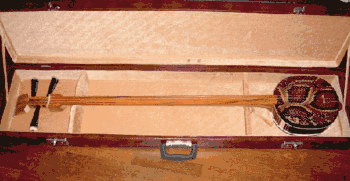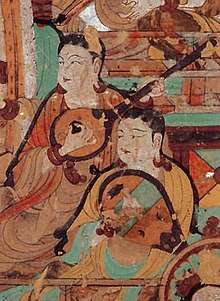Sanxian
| Sanxian | |||||||||||||||
 Chinese sanxian instrument | |||||||||||||||
| Traditional Chinese | 三弦 | ||||||||||||||
|---|---|---|---|---|---|---|---|---|---|---|---|---|---|---|---|
| Simplified Chinese | 三弦 | ||||||||||||||
| |||||||||||||||
The sanxian (Chinese: 三弦, literally "three strings") is a Chinese lute — a three-stringed fretless plucked musical instrument. It has a long fingerboard, and the body is traditionally made from snake skin stretched over a rounded rectangular resonator. It is made in several sizes for different purposes and in the late 20th century a four-stringed version was also developed. The northern sanxian is generally larger, at about 122 cm (48 in) in length, while southern versions of the instrument are usually about 95 cm (37 in) in length.
History

It has been suggested that sanxian, a form of spike lute, may have its origin in the Middle East, and older forms of spike lute were also found in ancient Egypt.[1] Similar instruments may have been present in China as early as the Qin dynasty as qin pipa (pipa was used as a generic term in ancient China for many other forms of plucked chordophones) or xiantao (弦鼗).[1][2] Some thought that the instrument may have been re-introduced into China together with other instruments such as huqin by the Mongols during the Yuan dynasty (1271–1368),[1][3] however, an image of a sanxian-like instrument was found in a stone sculpture dating from the Southern Song period (1217–79). The first record of the name "sanxian" may be found in a Ming dynasty text.[4][3]
The instrument was transmitted to other East Asian countries, for example to Japan as shamisen.[5]
Description
The sanxian has a dry, somewhat percussive tone and loud volume similar to the banjo. The larger sizes have a range of three octaves. It is primarily used as an accompanying instrument, as well as in ensembles and orchestras of traditional Chinese instruments, though solo pieces and concertos also exist. The sanxian is used in nanguan and Jiangnan sizhu ensembles, as well as many other folk and classical ensembles.
Traditionally the instrument is plucked with a thin, hard plectrum made from animal horn but today most players use a plastic plectrum (similar to a guitar pick) or, alternatively, their fingernails. This use of fingers to pluck the instrument often shares technique with that of the pipa and is most commonly used in performance of sanxian arrangements of works traditionally written for the pipa. This allows for pipa techniques such as tremolo to be used. Other techniques for sanxian include the use of harmonics and hitting the skin of the instrument with the plectra or fingernail (comparable to the technique used to play the northern Japanese tsugaru-jamisen).
A closely related musical instrument is the Japanese shamisen, which originated from the Chinese sanxian.[5][6][7] Even more closely related is the Okinawan sanshin, which is also covered in snakeskin. Additionally, the sanshin and sanxian share a structurally similar body part consisting of a round-edged square of wood. In the Japanese shamisen, the body (sao) is made of four pieces of wood instead of one. The Mongolian shanz and the Vietnamese đàn tam are also very similar to the sanxian.[8]
In addition to its use in traditional and classical Chinese music, some popular and rock musicians have used the sanxian, most notably the singer He Yong (何勇) and his father He Yusheng (何玉声).[9]
Although the sanxian has historically been one of the most popular Chinese folk instruments (particularly for accompanying singing), a major decline in the number of sanxian players in classical contexts has been the cause of great concern among enthusiasts of the instrument. As many Chinese orchestras exclude the sanxian, many people are unwilling to learn this instrument. Even in China, very few conservatories offer majors in sanxian, and the small number of students of this instrument, as compared to the guzheng or pipa, for example, have led to further concerns that the instrument's rich playing traditions may be lost forever. One reason for this is the fact that, unlike the shamisen in Japan, the sanxian lacks an original solo repertoire of its own, with most sanxian solo pieces being arrangements of pipa melodies, as in the case of "Big Waves Wash Against the Sands". For the most part, use of the sanxian in the Chinese orchestra is as a provider of a de facto bass line. Also, as the neck of the da sanxian is particularly long, there is a great deal of limitation on how virtuosic a sanxian player can be. This is not an issue in the smaller saxian, which are closer in size to the Japanese shamisen.
One likely reason for the decline in the instruments popularity is that it is extremely over priced. A similar 3-string instrument, the qinqin sells for about 1/10 the price and it is fretted. The sanxian is not fretted, and is actually a better instrument as the qinqin fretting is very odd, being based on a non-equal temperament diatonic scale. It's this odd fret scaling on the qinqin that limits its popularity.
Like the shamisen, the sanxian is an instrument particularly susceptible to humidity, although the snake skin used in the sanxian is somewhat more durable than the membranes of the shamisen. As such, storing the sanxian in an environment that is less humid can aid in prolonging the life of the snake skin resonator. Many musicians put silica gel in the instrument case to help keep the case from becoming overly humid.
Tuning
- Small sanxian: A-d-a or d-a-d1, Length: 95 cm (37 in)
- Large sanxian: G-d-g, Length: 122 cm (48 in)
Notable Sanxian players

- Li Yi
- Xu Fengxia
- Zhao Taisheng [10]
Related instruments
External links
Video
- Sanxian video from The Musical Instruments E-book
- Sanxian video Japan-based Sanxian performer.
Listening
- Sanxian audio (click headphones to listen to individual tracks)
See also
References
- 1 2 3 Myers, John (1992). The way of the pipa: structure and imagery in Chinese lute music. Kent State University Press. pp. 5–7. ISBN 9780873384551.
- ↑ "Sanxian". EasonMusic.
- 1 2 楊慎《昇庵外集》:「今次三弦,始於元時」。
- ↑ "Sanxian". Encyclopaedia Britannica.
- 1 2 Leiter, Samuel L. (2007). Encyclopedia of Asian Theatre: A-N. Greenwood Press. p. 445. ISBN 978-0-313-33530-3.
- ↑ Kodansha encyclopedia of Japan , Volume 7. 1983. p. 77. ISBN 978-0-87011-627-8.
- ↑ Lande, Liv (2007). Innovating musical tradition in Japan: Negotiating transmission, identity, and creativity in the Sawai Koto School. ProQuest LCC. p. 73. ISBN 978-0-549-50670-6.
- ↑ http://wn.com/shanz_&_yatga!!!_national_instruments_of_mongolia
- ↑ http://www.56.com/u35/v_OTA4ODE5MzY.html
- ↑ Zhao Taisheng at Hacken Lee Hong Kong Sinfonietta Live
- ↑ Chinese Music - Volumes 21-24 - Page 65 1998 "The full score from the xiansuo quartet "The Moon on High" showcases a fiddle, a pipa, a xianzi (the sanxian), and the zheng, in their strictly instrumental roles (see beginning of first movement below)."
- ↑ Liu Jianqiang Tibetan Environmentalists in China: The King of Dzi -0739199749 Page 188 2015 "The xianzi instruments looked like the Chinese two-stringed erhu, but even simpler. The sounds were coarse, simple and dry, unlike the fine melody produced by erhu, but folksier and more country-like."
- ↑ Journal of the American Musical Instrument Society 2002 "the "er" of "erxianzi" is the same as that of "erhu"; the "xian" means "string[ed]"; the "zi is a diminutive suffix ...